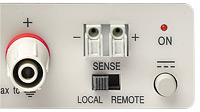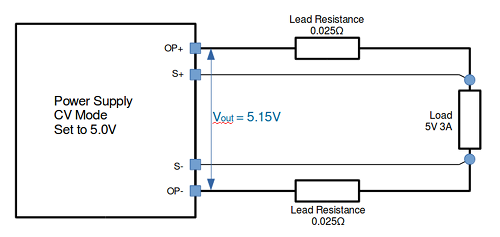Understanding Remote Sense for laboratory power supplies
Choose a power supply whose specifications actually mean something! When you need to buy a general purpose dc power supply, there are a bewildering number of manufacturers to choose from. When you read the specifications they all look much the same. Most quote load regulation figures of around 0.01%. Some quote a volt meter accuracy better than your DMM. In practice, however, these figures are almost meaningless if they omit the essential feature needed to achieve high accuracy and good load regulation: remote sensing. Even the best known names in the business omit remote sense from their lower cost power supplies - so does it really matter?
Remote Sense - do you really need it?
 Well, it depends on your application. If you're working at very low currents then probably not. If you don't need to know the voltage at the load accurately, then possibly not. What may not be obvious is how poorly regulated and inaccurate a power supply without remote sense can become. A two metre length of a 24/0.2 wire pair has a resistance of around 0.1Ω. For a 5V load drawing 3A, the metering error without remote sense would be 0.3V giving an effective full current load regulation of 6%. It makes a nonsense of specifications such as 0.01%.
Well, it depends on your application. If you're working at very low currents then probably not. If you don't need to know the voltage at the load accurately, then possibly not. What may not be obvious is how poorly regulated and inaccurate a power supply without remote sense can become. A two metre length of a 24/0.2 wire pair has a resistance of around 0.1Ω. For a 5V load drawing 3A, the metering error without remote sense would be 0.3V giving an effective full current load regulation of 6%. It makes a nonsense of specifications such as 0.01%.All Aim-TTi power supplies, with the exception of a few of the EL-R and EX-R series models*, have remote sense capability. You can choose local or remote sense at the flick of a switch, so if you don't need it, you don't need to use it.
Using Remote Sense
 A dc power supply operating in constant voltage (CV) mode uses a control loop to compare a "sensed" voltage with a reference voltage. In a higher quality laboratory power supply, the voltage to be sensed can be either at the output terminals of the PSU ("local sense") or at the load to which it is connected ("remote sense").
A dc power supply operating in constant voltage (CV) mode uses a control loop to compare a "sensed" voltage with a reference voltage. In a higher quality laboratory power supply, the voltage to be sensed can be either at the output terminals of the PSU ("local sense") or at the load to which it is connected ("remote sense").Using local sense does not compensate for the voltage drop caused by the resistance of the connecting leads, resulting in poor regulation. With remote sense connected, the control loop monitors the voltage at the load and keeps it constant, allowing the voltage at the output terminals to rise to compensate for the drop in the connecting leads. This results in near perfect regulation at the load.
Since the sense wires are part of the control loop, they should ideally use twisted pair shielded cable to reduce noise pickup. Twisting the power wires together separately may help in some applications. The power and sense wires must be securely connected at each end before enabling the output.
*Aim-TTi power supplies without remote sense: EL302P, EL302P-USB, EX355P, EX355P-USB and EX752M. Subject to change.
Adwords Conversion:
